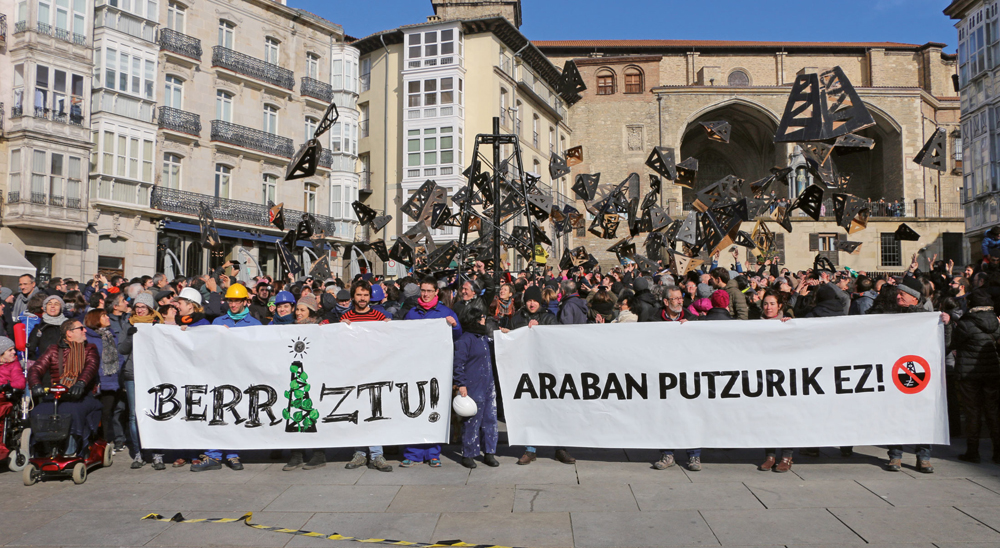Despite the fracking, the Basque Government is fixed on gas.
- Last October it was known that the Basque Government, through the SHESA society, is processing a permit to open a gas well in Subilla Gasteiz, where an attempt was made to puncture the fracking for years. Now that the law has ruled out hydraulic fracturing, the debate has already moved on to other areas. Above all to the question: Is it acceptable to invest public money in the search for gas?

In June 2015, the Basque Parliament passed a law that de facto prevents the use of fracking in the CAV. This decision forced him to change the intentions of the Basque Government, but not its main objective. The PNV, which opened the door for the approval of the law by abstention, has insisted that hydraulic fracture is today a technique without safety guarantees, but it is important to know how many hydrocarbons are in the subsoil of the CAV in one way or another.
Lakua has also maintained this thesis, mainly through the Department of Economic Development and Competitiveness headed by Arantza Tapia. Thus, in October 2016, the public company Hydrocarbons de Euskadi (SHESA), under the Basque Government, presented the project for the opening of the Armentia-2 gas well through conventional techniques. The project is located a few meters from the Armentia-1 well, where the first fracking drilling was planned, in Subilla, Vitoria-Gasteiz. There is already an amount allocated for this work, in the 2017 budgets that are in question these days: EUR 4.3 million. The total cost of the project is EUR 18 million.
Twenty years after the first lap
SHESA built the Armentia-1 well in 1997, but that was a failure; with the available techniques, almost no gas could be extracted, as the pit is low permeability. About a decade later, the Basque Government renewed its claim in the hope that by then all the underground gas could be extracted: the fracking. The later story is known. A maneuver by Patxi López caused everybody to talk about fracking and, by the way, the fight against it broke out; finally, the law that prevents it was passed.
Public investment in fossil fuels is a senseless setback, according to opponents of the Armentia-2 gas well project
“If fracking was necessary because conventional techniques did not work, how is it possible now to resubmit a project based on conventional techniques?” the opponents of the Armentia-2 project are asked. The SHESA, or what is the same, the Basque Government, is based on a report requested from the company Thrive Energy for EUR 53,600 to defend the viability of the project, even if it is not absolute certainty. “We think it can be cost-effective, but until the survey starts, nothing can be brought forward,” said SHESA’s technical director, Luis Muñoz, at a hearing in the Basque Parliament on 6 March. At the moment, the Spanish Ministry of the Environment is awaiting approval.
The energy model concerned
Fracking Ez was the first group to oppose the Armentia-2 project in the autumn. “The only novelty is the disappearance of the word fracking,” they stressed. So they decided to delegate the opposition work to other hands. The Berriztu group was born from the organization of an open assembly in Álava.
Berriztu’s goal is to paralyse Subijana’s well, but not only that: we have to discuss the energy model, to “raise awareness of society that we are on the wrong track,” said group member Estitxu Villamor. “They want us to believe that gas is a clean energy of transition, but if you put it into those infrastructures, you stop investing in other energy models, like renewables.”
Investing public money in fossil fuels is a senseless setback, says Berrizu. That is also the main argument used by two parliamentary groups, EH Bildu and Elkarrekin Podemos, who have demonstrated against the Armentia-2 project of the Abertzale coalition. Both have called for the withdrawal of the EUR 4.3 million budgeted for 2017, by means of partial amendments to be voted on 3 and 4 April in the Basque Parliament. The other party that opposes Shesa's claims is pp, but when it comes to writing these lines it is not certain what concrete position the popular would take in anticipation of the decision coming from Madrid.
Debates on hydrocarbons
“The environmental impact will be similar with or without fracking,” says Estitxu Villamor; “although the techniques are supposedly conventional, the pit is the same, unconventional.” This means that the amount of gas that can be extracted from a single drilling is very small, so the operation cannot be profitable without many wells. The development of the project could lead to excessive territorial occupation, according to the Berriztuk report.
According to the report prepared by Thrive, fracking would be the best way to extract gas at Subijana, but if there is no possibility of using it, modern conventional techniques could be applied. Among other things, because geological formation called Balmaseda is considered very heterogeneous, it presents differences that can be explored with conventional means. However, this argument has not convinced opponents of the profitability of the project or of the lack of risks.
It seems that, in any case, the central issue will not be the possible environmental impact of the project, although this is important, but the legitimacy of public investments in the search for hydrocarbons.
Greenpeaceko hainbat aktibistak A Coruñako portuan dagoen Medusa ikatz-biltegiaren sarrera blokeatu dute astearte goizean. Modu horretan, bertara zihoan Gas Natural-Fenosa konpainiaren –hura da biltegiaren jabea– kamioi batek bere zama hustea eragotzi dute... [+]
Espainiako Ekologistak Martxan taldeak eta AEBetako hainbat mugimenduk bat egin dute apirilaren 25ean sare sozialen bidez BBVAri eskatzeko Dakota Accces Pipeline oliobide proiektuari finantzazioa ken diezaiola. Barack Obamak oliobidearen eraikuntza geldiarazi zuen 2016ko... [+]
Araban, Subillako putzuan hasiriko proiektuari aurre egiteko Berriztu! taldea sortu da. Ingurumenean eta gizartean gasa ateratzeko zulaketek izan ditzaketen ondorioak ezagutaraztea eta proiektu horiek geldiarazteko presio egitea dituzte helburu.
Fracking Ez plataformak kezka agertu du Euskadiko Hidrokarburoak (SHESA), Eusko Jaurlaritzaren menpeko sozietate publikoa, Armentia-2 izeneko gas putzu baterako baimena tramitatzen ari delako. Subilla Gasteizen dago putzu hori, azken urteetan SHESAk fracking teknika erabiltzeko... [+]
Erregai fosilen ustiaketan liderrak diren multinazional handienak biltzen dira apirilaren 5etik 7ra Biarnoko Pauen MCE Deepwater Development 2016 kongresuan, itsaso sakonetako zundaketa teknikak hobetzeko, klimaren aldaketa konpontzeko egindako COP21 mundu biltzarraren... [+]
NASAko zientzialari ohi James Hansen oso kritiko agertu da Parisen egin zen COP21 bilerako akordioarekin. The Guardian kazetari adierazi dionez, karbono dioxido isuriak murrizteko lorturiko hitzarmena “iruzurra” izan da, “konpromiso hutsalak” besterik... [+]
Raul Zibechi kazetari uruguaitarra chavismoak azken urteotan eramandako bidearekin kritiko agertu da ezkerretik. Azken hauteskundeen bezperetan idatzi du Venezuelari buruz "Cruce de Caminos" artikuluan. Herrialde honetako edozer baldintzatzen duen datu nagusia... [+]
“Parisko Hitzarmenak ez du planeta salbatuko baina klima aldaketaren aurkako gurpila hasi da biratzen, eta ez da gutxi”. Txio batean idatzitako hitz horien bidez laburbildu du Unai Pascual BC3ko ikerlariak COP21 klimaren gailurra. Akordioaren behin betiko testua... [+]
Halakoetan ohi denez, bata bestearen ondoren iragarritako epeak behin betiko akordiorik gabe agortuz doaz Parisko klimaren goi-bileran. Ostiralerako behar zuena larunbat goizerako hitzeman du Laurent Fabius Frantziako Kanpo ministroak. Aldi berean mobilizazio erraldoiak espero... [+]
Aurreikusita zegoen bezala, COP21 klimaren gailurrean adostuko den nazioarteko hitzarmena ez da erabat loteslea izango. AEBek lortu dute akordioaren zirriborroa beren aldera lerratzera: herrialde bakoitzak aurkeztutako CO2 emisioak murrizteko planen betekizuna ez du nazioarteko... [+]
























